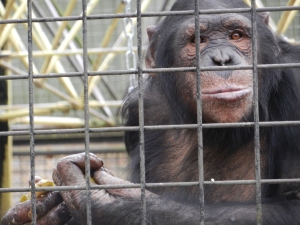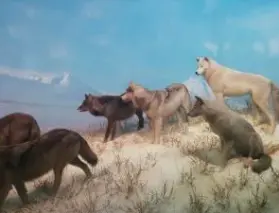At the beginning of her article “Are Animals ‘Things’?: The law evolves” (Harvard Magazine, March-April 2016), Cara Feinberg tells the story of a Texas couple whose family dog ran off and ended up in a shelter. The couple found him there the next day, but the shelter placed a “hold for owner” tag on the cage while the owners went to get cash needed to pay the fees. When they returned, the dog was gone. There had been a mix-up and the dog had been put to sleep.
The couple sued for damages. But in Texas their dog was only “property,” worth almost nothing, and loss-of-companionship damages applied only to human family members. They appealed on the grounds that “Texas courts had awarded damages for the sentimental value of personal property with little or no market value–such as lost heirlooms like jewelry, pistols, and hand-made bedspreads” (Feinberg). They won the appeal, but the state’s Supreme Court overturned the decision. That court ruled that a family dog that has provided such “rich companionship” cannot be forced into the same category as an heirloom. The couple’s quest ended. The dog was neither a piece of valuable property nor was it legally a human.

Gaining protection—and maybe rights
(jubbiz.files.wordpress.com)
The growing field of animal law, and the surging interest of law school students in it, focuses on this debate. The law treats everything as either a person or as property. Which one are animals? The growing body of law that protects animals–laws banning unethical hunting practices, gestation crates, and cock fighting, for example–rests on the assumption that animals are property. The animals’ owners bear the responsibility for their welfare. This is especially the case when the animals can experience fear and pain. A milestone in animal protection was reached in 2015 when, after many years of protection for “endangered” chimps in the wild, the U. S. government extended the same designation to chimps in research labs. It is now illegal to harm or kill a chimp anywhere in the U. S.
On the other hand, the view that animals are legal “persons” is making slow but significant headway. Significantly, other non-humans such as corporations and ships have been accepted in court as having legal rights. The first step in animals attaining such rights is their (chimps again, so far) gaining standing to be represented in a courtroom, and attorneys seeking to plead for their freedom or grieve their injuries are inching towards that goal. Over the centuries, the circle of beings embraced by the law has been expanding, gradually including women and slaves and others on the grounds that they are sufficiently “like us” to possess rights. The U.S. is hardly at the forefront in adding animals. In 1992, Switzerland amended its constitution to recognize animals as beings and not things. In 2002, Germany followed suit by adding the phrase “and animals” to a clause requiring the state to respect and protect the dignity of humans (USA Today, 5/18/2002).
But, as Feinberg points out, if animals become candidates for personhood and rights, “where should the law draw the line? Should primates have the same rights as humans? Should dogs? Should ants? What about animals in the wild, or those used in medical research, or the billions slaughtered for food?” It’s not surprising that we have empathy for the animals who are most like us—those that, like our pets, have intelligence and show feelings. But that empathy drops off quickly (and I think unfairly) when it comes to “lower” animals like rodents, fish, worms, and insects who have their own non-sentient responses and struggles.
Feinberg mentions that animal attorneys often become committed vegetarians because, as one lawyer quipped, attorneys don’t eat their clients. To me the joke hints at how abruptly the principles of animal rights can come face to face with biological imperatives. Perhaps, to clarify the law for animals, a middling category between property and persons will evolve, such as the single basic right of bodily liberty, as advocate Stephen Wise has suggested. But liberty from which constraints, for which animals? Perhaps the language of the Swiss and German constitutions moves us closer to a synthesis of rights and protections, but for animals under which conditions?
Subscribe to The Spiritual Naturalist Society
Learn about Membership in the Spiritual Naturalist Society
__________
The Spiritual Naturalist Society works to spread awareness of spiritual naturalism as a way of life, develop its thought and practice, and help bring together like-minded practitioners in fellowship.












